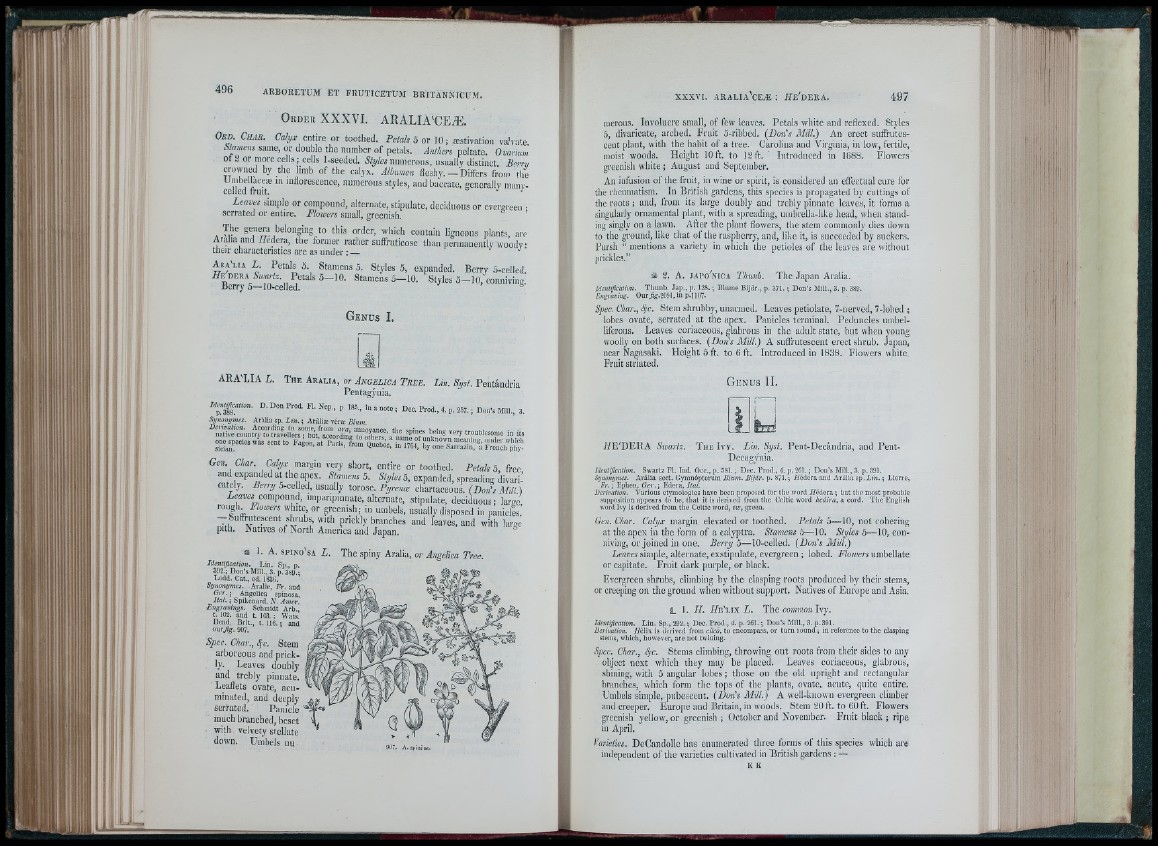
"1l¡
ï i '
.....
ARBORETUM ET FRUTICETUM BRITANNICUM.
O r d e r XXXVI. ARALIA'CEÆ.
XXXVI. a r a l ia ' c eæ : í í e ' d e r a . 4 9 7
Or d . Chah. Calyx entire or toothed. Petals 5 or 10 ; æstivation valvate
bflmens same, or double the number of petals. Anthers peltate. Ovarium
of g or more cells ; cells I-seeded. numerous, usually distinct. if»m/
crowned by the limb of the calyx. Albumen fleshy. — Differs from the
Uinbellaceæ in inflorescence, numerous styles, and baccate, senerally many-
celled fruit. ° ^
Leaves simple or compound, alternate, stipulate, deciduous or evergreen •
serrated or entire. Flowers small, greenish.
The genera belonging to this order, which contain ligneous plants, are
Aralia and J/edera, the former rather suffruticose than permanently woodv •
their characteristics are as under : j j •
A r V h a L . Petals 5 . Stamens 3 . Styles S, expanded. Berry S-celled.
t o r ? ? - IO ? e l l e d ® conniying.
G e n u s I.
ARA'LIA L. T h e A r a l i a , or Angelica T ree. Lin. Syst. Pentándria
Pentagyiiia.
P “ > “ »‘o i P r e i . I- p. 257.1 Don’s Mill., 3.
Synotiymcs. ArMia sp. L tn . ; ArSli® vera? Blum.
Gen. Char. Calyx margin very short, entire or toothed. Petals 3 free
and expanded at the apex. Stamens 5. Styles 3, expanded, spreading divari!
catdy. Beiry S-celled, usually torose. Pyrena chartaceous. (Don’s M iU)
Leaves compound, itnparipinnate, alternate, stipulate, deciduous: larae
rough Flowers white or greenish; in umbels, usually disposed in paniclls.’
— Snffrutescent stoiibs, with prickly branches and leaves, and with large
pith. Natives of North America and Japan.
5É 1. A. spino'sa L. The spiny Aralia, or Angelica Tree.
Identification. Lin. Sp., p.
392.; Don’s Mill., 3. p. 3S9.;
Lodd. Cat., ed. 1836.
Synonymes. Aralie, Fr. and
G e r ,} Angelica spinosa
I ta l . ; Spikenard, N. Amer.
Engi-avings. Schmidt Arb.,
t. 102. and t. 103. : Wats
Dend. Brit., t. 116.; and
our/íá’- 907.
Spec. Char,, 4c. Stem
arboreous and prickly.
Leaves doubly
and trebly pinnate.
Leaflets ovate, acuminated,
and deeply
serrated. Panicle
much branched, beset
with velvety stellate
down. Umbels nu
merous. Involucre small, of few leaves. Petals white and reflexed. Styles
5, divaricate, arched. Fruit 5-ribbed. (Doii’s Mill.) An erect suffrutescent
plant, with the habit of a tree. Carolina and Virginia, in low, fertile,
inoist woods. Height 10 ft. to 12 ft. Introduced in 1688. Flowers
greenish white j August and ¡September.
An infusion of the fruit, in wine or spirit, is considered an effectual cure for
the rlieumatism. In British gardens, this species is propagated by cuttings of
the roots ; and, from its large doubly and trebly pinnate leaves, it forms a
singularly ornamental plant, with a spreading, uinbrella-like head, when standing
singly on a lawn. After the plant flowers, the stem commonly dies down
to the .ground, like that of the raspberry, and, like it, is succeeded by suckers.
Pursh “ mentions a variety in which the petioles of the leaves are without
prickles.”
áfe 2. A. j a p o 'n i c a Thunb. The Japan Aralia.
Idenlifkation. Thunb. Jap., p. 128.; Blume Bijilr., p, 371.; Don’s Mill., 3. p. 389.
Engraving. OurJ?g.2091.in p.1107-
Spec. Char., Stem shrubby, unarmed. Leaves petiolate, 7-nerved, 7-lobed ;
lobes ovate, serrated at the apex. Panicles terminal. Peduncles umbelliferous.
Leaves coriaceous, glabrous in the adult state, but when youngwoolly
on both surfaces. {Doris Mill.) A suffi’utescent erect shrub. Japan,
near Nagasaki. Height 5 ft. to 6 ft. Introduced in 1838. Flowers white.
Fruit striated.
//E 'D E R A Swartz.
G e n u s 1Í.
Tiiii Ivy. Lin. Syst. Pent-Decándria, and Pent-
Decagjnia.
Identification. Swartz Fl. Ind. Occ., p. 5 8 1 .; Dec. Prod., 4. p. 261.; Don’s Mill., 3. p. 391.
Synonynies. Arália sect. Gymnópterum Blum. Bijdr. p . 871. j //éd e ra and Aralia sp, L m . ; L ien e ,
F r.; Ephen, Ger.; Edera, iia/.
Derivation. Various etymologies have been proposed for the word //éd era ; but the most probable
supposition, ajipears to be, that it is derived from the Celtic word hedira, a cord. The English
word Ivy is derived from the Celtic word, iw, green.
Gen. Char. Calyx margin elevated or toothed. Petals 5—10, not cohering
at the apex in the form of a calyptra. Stamens 5—10. Styles 5—10, conniving,
or joined in one. Beny 5—10-celled. (Don's Mill.)
Leaves simple, alternate, exstipulate, evergreen ; lobed. Flowers umbellate
or capitate. Fruit dark purple, or black.
Evergreen shrubs, climbing by the clasping roots produced by their stems,
or creeping on the ground when without support. Natives of Europe and Asia.
a_ 1. -if. HeY ix L. The common Ivy.
• Identification. Lin. Sp., 292.; Dec. Prod., 4. p. 261.; Don’s Mill., 3. p.391.
Derivation. í/é lix is derived from died, to encompass, or turn i o u n d ; in reference to the clasping
stems, which, however, are not twining.
Spec. Char., <^c. Stems climbing, throwing out roots from their sides to any
object next which ihey may be placed. Leaves coriaceous, glabrous,
shining, with 5 angular lobes; riiose on the old upright and rectangular
branches, which form the tops of the plants, ovate, acute, quite entire.
L'mbels simple, pubescent. (Doris Mill.) A well-known evergreen climber
and creeper. Europe and Britain, in woods. Stem 20 ft. to 60 ft. Flowers
greenish yellow, or greenish ; October and November. Fruit black ; ripe
in April.
Varieties. DeCandolle has enumerated three forms of this species which are
independent of the varieties cultivated in British gardens : —
'• I I
f